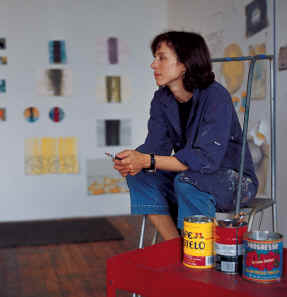- A Career
in Art

By Jim H. Smith
When you’re young and talented and on the verge of adulthood, it’s understandable if you’re overwhelmed by the urge to find yourself; to go where no one knows you and invent yourself there, where no one has preconceptions about you.
That was Ellen Burchenal. One of six children, she needed a place where she could explore all the myriad things that were simultaneously capturing her attention; a place where she could shake it all up, and see what happened. And she found that place, in Hartford, Connecticut.
“When I came to Trinity, I was interested in so many things,” the Baltimore artist recalls. “I took all kinds of classes—French lit, probability and statistics, calculus.” And lots of art classes.
It was in those classes, a quarter of a century ago, that she met Professor George Chaplin, whom Burchenal remembers as “one of the best teachers” she ever had, a role model who “would challenge you and help you think things out for yourself.”
Chaplin was director of the studio arts program at that time, and he remembers Burchenal, who was his teaching assistant, as the kind of student who could stand up to the challenge. “Her commitment and ability were of the highest order,” he says. “She was talented and intelligent. She had a great sense of humor, and she was very competitive.”
Burchenal had always been interested in art, but it was at Trinity, under Chaplin’s guidance, that she began to discover just how important that interest was. In 1976, she pursued that interest to Rome, where she studied at the Barbieri Center.
Rome, she says, “changed my life.” The trip convinced her, among other things, that she wanted to be an artist. So, after graduating from Trinity, Phi Beta Kappa, in 1978, she moved to Boston, where she worked as a waitress at Faneuil Hall and got her first studio.
Two years later, she went back to Rome for a more extended stay. And this time, when she returned to the United States, she enrolled in the Mount Royal Graduate School of Art, at the Maryland Institute of Art, from which she earned her MFA degree in 1982.
What has followed, says Burchenal, has been “an interesting life.” She has remained self-employed for the last two decades, working on a variety of jobs, while building her artistic reputation. What you gain, in this sort of experience, she says, is “an opportunity to glimpse other people’s lives as you take a variety of different jobs—that is, of course, if you can get above the anxiety over where your next meal will come from.”
Burchenal’s husband, Baltimore photographer John Dean, has played an important role in helping her learn how to handle the anxiety. She met him in Baltimore in the mid-1980s. “He, more than anyone, set an example for being self-employed,” she says. “He has been a freelancer for 20 years and he has a relaxed attitude toward it. He always knows that work will come.”
An artistic breakthrough
Indeed, for Burchenal, work has followed her acceptance of the role of artist. In 1990, her show, Figuring Eros, represented an artistic breakthrough. Presented at the Snug Harbor Cultural Center, on Staten Island, New York, it was her first show outside of Baltimore. And it helped open doors.
In 1995, she completed a major commission she’d won in the late 1980s, to produce four-color laminated glass walls for the Baltimore Metro subway tunnel beneath Market Place Station. The installation, Undercurrent, is immense, running 450 feet on each side of the station. And it features an image that has dominated Burchenal’s work for nearly 20 years—disks, ellipses, or lozenges that, she says, have something to do with remembering the past or remembering places.
Burchenal finds it difficult to explain what her work—which has also come to feature images of baby spoons and small shoes since the birth of her son, Charlie, a year and a half ago—is specifically about. “I’m trying to articulate what is true for me,” she says.
What clearly seems true for her is that she has found wellsprings of contentment in her family and in a career, that in key respects, began in Hartford, nearly 30 years ago, as a student of Professor Chaplin.
Since her initial, life-altering trip to Rome, while she was still a Trinity student, she has returned to Italy 12 times. And for the last six years—as director of Sorrento Summer: Experiencing Southern Italy through Painting & Drawing, a program of the Maryland Institute of Art International Program—she has spent a month there each summer, teaching groups of 16 students, sharing truths an artist can only learn over time, on the job, just by living.